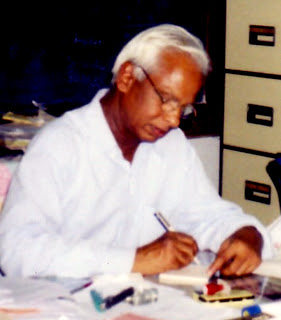He said more than once in his Mahabharata that he was born to write Vishnu Purana. He repeatedly called his
composition “Vishnu Purana”. For him
the story of the Kurus was worth telling because it gave him the opportunity to
describe the lila of Vishnu in his avatara as Krishna. His Mahabharata incorporates episodes from Srimad Bhagavata, Harivansa
and Skanda Purana. Thus in a sense
composing Mahabharata was never an
option for him, not something he had decided to do; doing it was his destiny! And
what did he do? A number of times he said in his narrative that it was goddess Sarala who really composed
and told him the couplets and he simply wrote them down. He wasn’t therefore
the creator of the narrative, he was merely the scribe. Saying these, he was
probably protecting himself from attacks of the Sanskrit-knowing scholars, the brahmins,
who constituted the powerful educational authority of his days. A non-brahmin,
he had not merely composed (or rather “dared to compose”) Mahabharata in Odia (this was the first time any classical text was
composed in Odia), he had the temerity to deviate from Vyasa Mahabharata to such a significant extent.
It is said about the sixteenth
century Odia poet Jagannatha Dasa that he wrote Srimad Bhagavata in Odia language so that his mother who did not
know Sanskrit would understand this sacred composition and gain religious merit
(punya). Nothing of this sort has
been said about Sarala Dasa. Surely those who came to listen to his composition
did not know Sanskrit and were excluded from the educationally privileged section
of the society. They were in his mind when he retold the story; one’s audience
is always in one’s mind when one narrates a story. But he made no mention of it
in his narrative. May be we can conclude that Sarala’s narrative purpose was
the purpose of every creative artist, namely to express himself, and as a
teller of a puranic story, his purpose was the same as the composers of all
puranas, namely to delight, edify and spiritually elevate his audience.
Incidentally in Sarala Mahabharata there is no mention
of sarpa jajna (snake sacrifice).
There is no mention of the curse on King Parikshita, his death on account of
that curse and his son, Janmejaya’s revenge. In Sarala’s retelling, the sages
of Naimesharanya were not the listeners of the Mahabharata story from Suta,
which he had heard at the sarpa jajna
of King Janmejaya. Here sage Agastya (better known in the relevant literature
as “Agasti”) was the narrator and the great king Vaibasuta Manu was his
listener. After worshiping him, the King prayed to the great seer to tell him
how to attain moksa and in response the sage began his narrative, which was
about moksa, not jaya (victory). For
Agastya, for Sarala by implication, listening with devotion to the lila of
Narayana is what would bring moksa to the listener.
If Mahabharata, i.e., Vishnu
Purana, is to be the narrative of moksa, could it be most appropriately
contextualized in a violent situation, where a grieving and angry king was
seeking revenge on the killer of his father through a terrible jajna that would destroy all snakes?
Isn’t a shishya seeking the marga (path) to moksa from a guru, who
was a seer, a more appropriate context for Visnu
Purana?

No comments:
Post a Comment